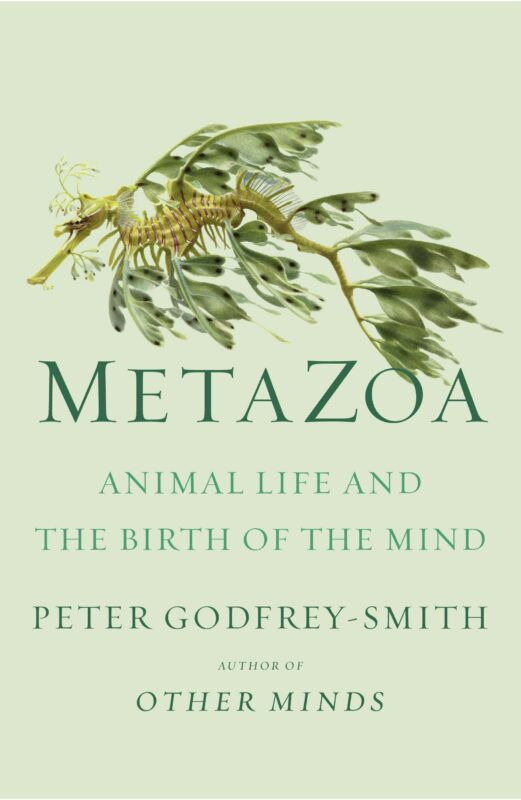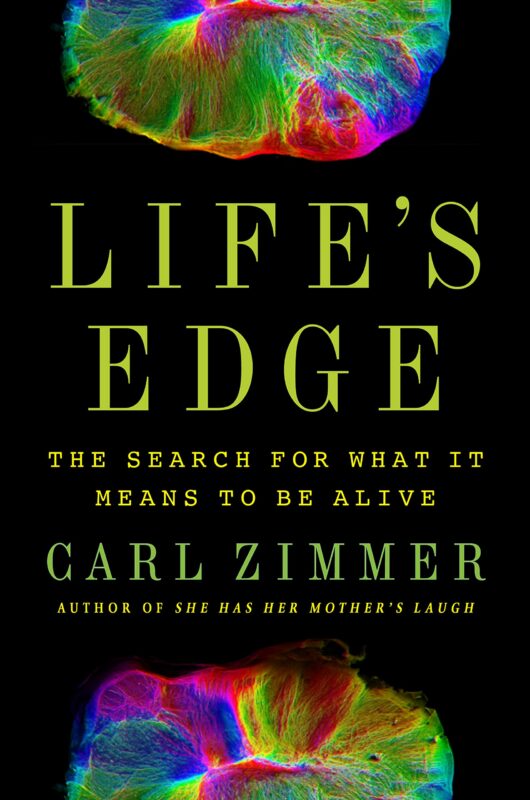The Humbling Complexity of the Hard Problem
Review of
Metazoa: Animal Life and the Birth of the Mind
New York, NY: Farrar, Straus and Giroux, 2020, 352 pp.
Life’s Edge: The Search for What It Means to Be Alive
New York, NY: Dutton, 2021, 368 pp.

It’s always unsettling to wake up in the morning and learn that you slept unawares through a massive thunderstorm or the cat’s house-wide rampage. It’s a more quotidian version of what people who have been anesthetized for a medical procedure describe as a sheer blankness, a profound nothing. Our brains have been switched off while significant things happen to or around our heedless bodies.
What accounts for the difference between the times when we are completely conscious of ourselves and our perceptions, our surroundings, and the presence of others, and the times when we are utterly disconnected from our senses, our thoughts, and our feeling of being present in the world?
The study of conscious experience and its biological instantiation in brain activity has fascinated philosophers and scientists for centuries. But they are not the only ones to ponder the mysteries of consciousness; everyday experiences prompt us to wonder who (or what) is conscious and who (or what) is not. Most people seem likely to agree that we and the other humans we encounter are conscious but that our kitchen table and flowerpot are not. How do we confidently make such distinctions? And are our pets conscious? What about trees? When faced with decisions about our dog or a beloved oak, the confidence that our determinations of consciousness are being made on firm ground begins to wobble.
The wobble comes to us honestly. For millennia, scholars have argued over solutions to what philosopher David Chalmers dubbed “the hard problem of consciousness”: How does the phenomenon of conscious awareness—the feeling of being conscious—arise from the physical brain? It’s one thing to describe the mechanics of signal transduction and the cell computations of the brain that turn light falling on our retinas into a visual representation of a baseball, for example, and quite another to explain the feelings or thoughts we experience when we see and recognize that baseball. How does the recognition of hardness, color, or roundness—let alone the emotion conjured as you remember playing catch with a parent—come into the picture?
Most people seem likely to agree that we and the other humans we encounter are conscious but that our kitchen table and flowerpot are not. How do we confidently make such distinctions? And are our pets conscious? What about trees?
In the past few decades, neuroscientists and psychologists have waded into the fray, bringing with them a rapidly expanding trove of details documenting the brain’s biology and cognitive processing. As a result, scientists’ understanding has shifted from a unitary view of consciousness—you either have it in full or you don’t have it all—to carving up the hard problem into three broad areas. This new understanding allows for some distributed forms of consciousness by examining the content of consciousness (recognizing the redness of an apple), levels of consciousness (being fully awake as opposed to half asleep), and awareness of and reflection on the self (experiencing the sense of an “I” that’s doing the thinking). The inclusion of brain science in the philosophical question of consciousness has exploded interest in consciousness studies and inspired a spate of books on the subject.
Two recent and welcome additions to this trend are the lyrical Metazoa: Animal Life and the Birth of the Mind, by the philosopher Peter Godfrey-Smith, and the breezy but engaging Life’s Edge: The Search for What It Means to Be Alive, by the science journalist Carl Zimmer. Both books are aimed at more general audiences, and Godfrey-Smith and Zimmer immediately hook the reader by posing deceptively simple questions. How do we know something is alive? Which organisms do we believe have conscious experiences? The authors are charming companions on the quest for answers as they journey through evolutionary time, challenging our assumptions and shifting the epistemological ground beneath our feet. And both books satisfyingly engage with questions that had begun to bother me while reading earlier volumes, often written by prominent neuroscientists, on the nature of consciousness.
Those books—notably The Mind: Consciousness, Prediction, and the Brain, by E. Bruce Goldstein, The Consciousness Instinct: Unraveling the Mystery of How the Brain Makes the Mind, by Michael S. Gazzaniga, and The Feeling of Life Itself: Why Consciousness Is Widespread but Can’t Be Computed, by Christof Koch—provide an engaging tour through the world of contemporary neuroscience. They offer, as their titles suggest, various perspectives on defining consciousness. But as good and interesting as these books are, I found myself dissatisfied with their conclusions about the connection between mind and matter. Partially, this is the result of a slippage of terms; “consciousness” as explored by neuroscience is largely the study of perception, awareness, attention, and other familiar laboratory constructs. This is not to say that neuroscientific and psychological revelations about how we perceive and interact with the world around us are not fascinating. But they don’t satisfyingly answer the less tractable—dare I say metaphysical?—questions raised by the hard problem of consciousness.
Another reason that books attempting to tell the story of consciousness in its human manifestation seem not to fully live up to their promise is that they tell a tale that begins at the end. More recently, however, a few books about consciousness took a different tack. Rather than attempt to explain the phenomenon of full-blown human consciousness—a late arrival on the evolutionary stage—some scholars are attempting to peer through an evolutionary lens down the long timescales of the history of life to describe not what consciousness “is” but how it came to be. A stellar example of this approach is Glenn Northcutt and Georg Striedter’s scholarly tour de force, Brains Through Time: A Natural History of Vertebrates, which I reviewed in the Winter 2021 Issues.
Rather than attempt to explain the phenomenon of full-blown human consciousness—a late arrival on the evolutionary stage—some scholars are attempting to peer through an evolutionary lens down the long timescales of the history of life to describe not what consciousness “is” but how it came to be.
Metazoa and Life’s Edge continue in this promising vein. In Metazoa, Godfrey-Smith weaves philosophical inquiry with biological details of creatures from very different regions of the animal kingdom. He produces a tapestry showing how, through genetic mutations and natural selection, evolution prompts a suite of adaptions that equips organisms to first sense, then respond to, and finally interact with their environment and the challenges it poses.
Metazoa expands Godfrey-Smith’s thinking on adaption, consciousness, and intelligence from his prior work on the philosophy of biology. He broadens his view to include a richer collection of organisms. In ten wide-ranging chapters we are introduced to the strange and wonderful biology of captivating lifeforms (mostly water-dwelling) across the evolutionary spectrum. These include the single-celled protozoa (precursors to the metazoa), glass sponges, coral, shrimp, octopus, kingfish, and other animals that capture our imagination by taking us far from the familiar organisms that fill standard biology texts.
Godfrey-Smith convincingly traces how the single-celled organism’s need to keep track of what is “inside” versus “outside” its cell membrane gives rise to the multicellular organism’s rudimentary sense of self. Once you have evolved the membranes and ion channels needed for the electrically polarized membranes to distinguish what is inside and what is out, you are off to the races. As evolution continues, its tweaks and happy accidents eventually land us at our own self-awareness.
With the emergence of animals that could creep over their landscape during the Ediacaran Period more than 600 million years ago, Godfrey-Smith observes, “an evolutionary pathway becomes visible, one that begins with moving slowly toward food, and then not so slowly, as others may get there first. This produces an ‘arms race.’ Once animals are trying to eat you … it pays to improve one’s own senses and means of motion.” Specialized sensory organs such as eyes become an advantage, as do specialized limbs. Of course, a bigger brain helps too, enhancing information processing and communication and eventually allowing for the collective advantage of social groups. For Godfrey-Smith, conscious awareness of an organism’s environment is not a single thing, and it is not uniquely human. I wish reading Metazoa was every student’s first introduction to the beauty and power of evolutionary biology.
For Godfrey-Smith, conscious awareness of an organism’s environment is not a single thing, and it is not uniquely human.
Although Godfrey-Smith’s stated intention is to probe questions about animal consciousness, the book winds up dwelling on the far broader question of what being alive actually means. In Life’s Edge, Zimmer also takes the long view of animal evolution, but he embraces the question of what it means to be alive explicitly and with the enthusiasm of an accomplished and successful storyteller. Zimmer has crafted an eminently readable tale, told through the stories and personal anecdotes of the scientists who have devoted their research to defining the essence of life.
I thoroughly enjoyed Zimmer’s perspective on biology as a messy and sometimes frustrating quest for understanding, rather than the dry collection of facts so often presented in textbooks. Organized into four parts, the book is a good introduction to both the scientific search for understanding what it means to be “alive” and the promises and limitations of scientific knowledge when it comes to philosophical questions—such as what it “means” to be alive.
In addition to evolutionary and historical perspectives, Zimmer examines the science involved in contemporary controversies, including over synthetic biology and human-animal chimeras—which often hinge on different ideas about what constitutes living matter. He even wonders if the dreaded virus responsible for the global COVID-19 pandemic is alive. And the answer is complicated—which is the point. At the outer edges of what constitutes life, on our own planet and possibly elsewhere in the universe, hard and fast rules about what’s alive and what’s not don’t apply in the ways we’re used to.
Zimmer has crafted an eminently readable tale, told through the stories and personal anecdotes of the scientists who have devoted their research to defining the essence of life.
Life’s Edge is a wonderful book, but active researchers may roll their eyes a bit at the invariably tireless and brilliant scientists who people Zimmer’s pages. They likely know many of these scientists or others like them, and know that sometimes researchers are arrogant, wrong, or tired. Although understandable on some levels, the portrayal of scientists as superheroes can ring hollow after a while.
Both Metazoa and Life’s Edge are infused with a meta-theme: a cautionary tale about reductionism and the fruitless quest for a characteristic scientists can point to and say, “Here is consciousness, here is aliveness.” Zimmer masterfully sums this up by quoting the brilliant but troubled biochemist (and Nobel laureate) Albert Szent-Györgyi: “I moved from anatomy to the study of tissues, then to electron microscopy and chemistry, and finally to quantum mechanics. This downward journey through the scale of dimensions has its irony, for in my search for the secret of life I ended up with atoms and electrons, which have no life at all. Somewhere along the line, life has run through my fingers.”
Yes, yes, and yes. Godfrey-Smith and Zimmer offer antidotes to the lure of the “downward journey” by embracing the humbling complexity and ambiguity of biology.

